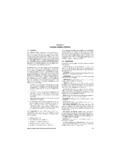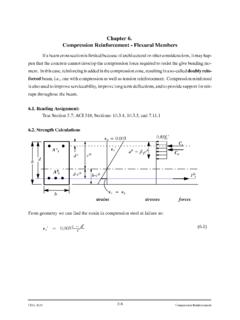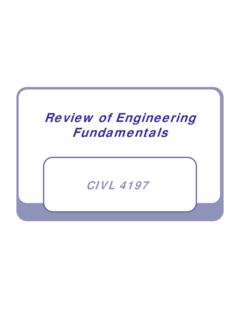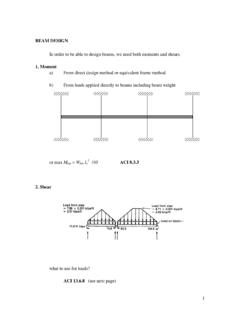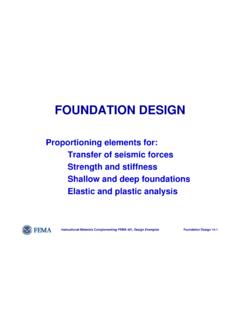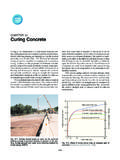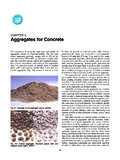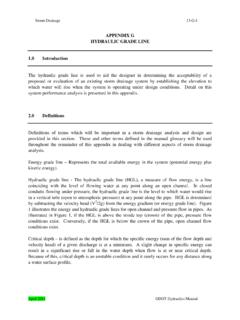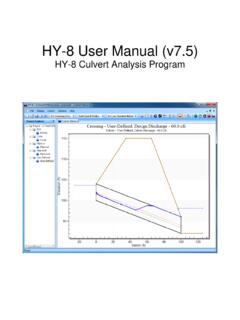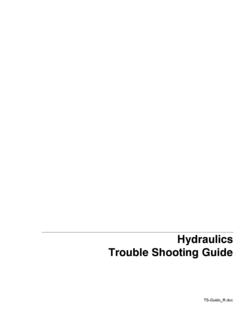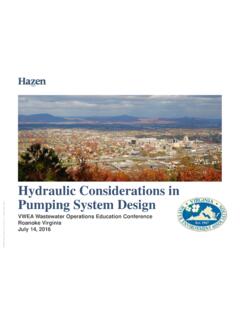Transcription of Head Loss Calculations - Memphis
1 1 Civil Engineering Hydraulics Mechanics of Fluids Head Loss Calculations Bernoulli and Pipe Flow The Bernoulli equation that we worked with was a bit simplistic in the way it looked at a fluid system All real systems that are in motion suffer from some type of loss due to friction It takes something to move over a rough surface Pipe Flow 2 2 Bernoulli and Pipe Flow Consider flow in a constant-diameter pipe Pipe Flow 3 Bernoulli and Pipe Flow If we look at the energy at points 1 and 2. Pipe Flow 4 p1 +v122+z1g=p2 +v222+z2g3 Bernoulli and Pipe Flow Since this system is horizontal, z1 = z2 so Pipe Flow 5 p1 +v122=p2 +v222 Bernoulli and Pipe Flow The pipe has a constant diameter and the flow is constant at both sections so the velocity at each point is the same.
2 Pipe Flow 6 v1=v2p1 +v122=p2 +v222p1 =p2 4 Bernoulli and Pipe Flow Since we are dealing with an uncompressible fluid, the pressures at points 1 and 2 should be the same. Pipe Flow 7 p1 =p2 p1=p2 Bernoulli and Pipe Flow If we ran the system experimentally and measured the two pressures, they would not be the same. Pipe Flow 8 p1 =p2 p1=p25 Bernoulli and Pipe Flow The pressure at point 2 would be lower than the pressure at point 1. Pipe Flow 9 p1 =p2 p1=p2 Bernoulli and Pipe Flow The pressure is being lost (actually the pressure energy) due to friction as the flow moves along the pipe. Pipe Flow 10 p1 =p2 p1=p26 Friction losses To be able to quantify what is happening we need to look an element of flow in the pipe.
3 Pipe Flow 11 Friction losses The grey element on the right is an element of the flow, a slice like a quarter. Pipe Flow 12 7 Friction losses The thickness of the quarter is dz and it has a perimeter length of P ( D) This makes the area in contact with the sides of the pipe equal to Pdz = Ddz At the wall there is a shearing stress, w, which is the stress between the wall and the outer layer of the fluid Pipe Flow 13 Friction losses Then the force from the wall on the section of fluid (opposing the fluid flow) will be equal to Pipe Flow 14 Fretarding= wPdz= w Ddz8 Friction losses The pressure on the upstream (left face)
4 Of the section will produce a force accelerating the section Pipe Flow 15 Fretarding= wPdz= w DdzFaccelerating=pA=p D24 Friction losses As we move from the left face to the right face (dz) the change in pressure will equal dp Pipe Flow 16 Fretarding= wPdz= w DdzFaccelerating=pA=p D249 Friction losses So this will add an additional retarding force Pipe Flow 17 Fretarding= w Ddz+p+dp() D24 Faccelerating=pA=p D24 Friction losses Since both the velocity and mass flow rates as the same on both sides of the section, there is no net force on the section (conservation of momentum) Pipe Flow 18 Fretarding= w Ddz+p+dp() D24 Faccelerating=pA=p D24 Faccelerating Fretarding=010 Friction losses Therefore Pipe Flow 19 Fretarding= w Ddz+p+dp() D24 Faccelerating=pA=p D24 Faccelerating Fretarding=0p D24 w Ddz p+dp()
5 D24=0 w Ddz D24dp=0 Friction losses Rearranging Pipe Flow 20 w Ddz D24dp=0 w Ddz= D24dp w D D24=dpdz11 Friction losses So we have an expression for the rate at which the pressure changes as the flow moves downstream Pipe Flow 21 w Ddz D24dp=0 w Ddz= D24dp w D D24=dpdzFriction losses In the simplest form Pipe Flow 22 w D D24=dpdz 4 wD=dpdz12 Friction losses Generalizing to any shape pipe we substitute the hydraulic diameter for the pipe diameter Pipe Flow 23 4 wDh=dpdzFriction losses At this point, we can introduce another dimensionless ratio, the friction factor, f Pipe Flow 24 4 wDh=dpdz13 Friction losses The friction factor, f, is the ratio of the friction forces to the inertia forces.
6 Pipe Flow 25 4 wDh=dpdzf=4 w12 v2 Friction losses Combining the two expressions. Pipe Flow 26 f12 v2Dh=dpdz14 Friction losses Isolating the differentials Pipe Flow 27 f v22 Dhdz=dpFriction losses Now back to the pipe we originally considered Pipe Flow 28 f v22 Dhdz0L =dp 15 Friction losses Integrating Pipe Flow 29 f v22 Dhdz0L =dp fL v22Dh=p2 p1 Friction losses Usually we break this expression into two terms Pipe Flow 30 fL v22Dh= v22fLDh=p2 p116 Friction losses So we have a modified form of the Bernoulli equation that takes into account the friction losses in the system Pipe Flow 31 p1 +v122+z1g v22fLDh =p2 +v222+z2gThe pressure
7 Change term takes that form because we are using energy terms in this expression. Friction losses Reducing Pipe Flow 32 p1 +v122+z1g v22fLDh=p2 +v222+z2g17 Friction losses And rewriting the expression in terms of head Pipe Flow 33 p1 g+v122g+z1 v22gfLDh=p2 g+v222g+z2 Friction losses So the downstream energy (at point 2) is lower than the energy at point 1 Pipe Flow 34 p1 g+v122g+z1 v22gfLDh=p2 g+v222g+z218 Example A 2-nominal pipe is inclined at an angle of 30 with the horizontal and conveys m3/s of water uphill. Determine the pressure drop in the pipe if it is 7 m long. Take the friction factor f to be Pipe Flow 35 Example A 2-nominal pipe is inclined at an angle of 30 with the horizontal and conveys m3/s of water uphill.
8 Determine the pressure drop in the pipe if it is 7 m long. Take the friction factor f to be Pipe Flow 36 The 2-nominal refers to the pipe size. At one time, it would have been the inside diameter of the pipe in inches but that is no longer the case. Like the 2 by 4 in lumber, it is now just a reference. Table in the back of the book gives the critical dimensions for the pipe. If no schedule (has to do with wall thickness and strength of the pipe) you may assume that it is the most common, Schedule 40. 19 Example A 2-nominal pipe is inclined at an angle of 30 with the horizontal and conveys m3/s of water uphill.
9 Determine the pressure drop in the pipe if it is 7 m long. Take the friction factor f to be Pipe Flow 37 We can draw a sketch of the system and use the modified Bernoulli expression to answer the pressure drop. Example A 2-nominal pipe is inclined at an angle of 30 with the horizontal and conveys m3/s of water uphill. Determine the pressure drop in the pipe if it is 7 m long. Take the friction factor f to be Pipe Flow 38 We have the volumetric flow rate so we can calculate the average velocity at points 1 and 2. Since they have the same cross sectional area, their average velocities will be the same.
10 20 Example A 2-nominal pipe is inclined at an angle of 30 with the horizontal and conveys m3/s of water uphill. Determine the pressure drop in the pipe if it is 7 m long. Take the friction factor f to be Pipe Flow 39 If we set the reference plane through the left end of the system at point 1, then we can calculate the elevation of point 2 from the reference plane from the information given in the problem. Example A 2-nominal pipe is inclined at an angle of 30 with the horizontal and conveys m3/s of water uphill. Determine the pressure drop in the pipe if it is 7 m long. Take the friction factor f to be Pipe Flow 40 Using the loss term we developed we can determine the pressure drop (in units of head) due to the friction in the pipe.
